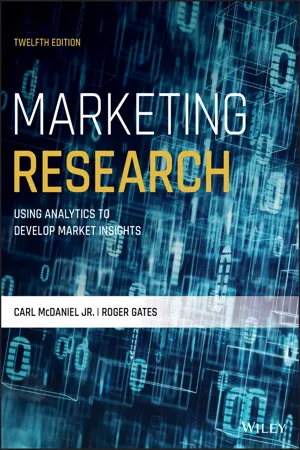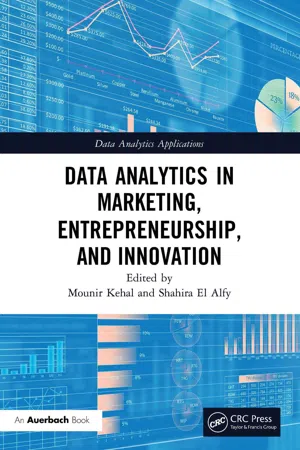Marketing
Marketing Analytics
Marketing analytics involves the use of data and statistical analysis to evaluate marketing performance and optimize strategies. It encompasses the measurement and interpretation of various marketing metrics to gain insights into customer behavior, campaign effectiveness, and return on investment. By leveraging marketing analytics, businesses can make data-driven decisions to enhance their marketing efforts and achieve better results.
Written by Perlego with AI-assistance
Related key terms
1 of 5
8 Key excerpts on "Marketing Analytics"
- eBook - PDF
- Carl McDaniel, Jr., Roger Gates(Authors)
- 2020(Publication Date)
- Wiley(Publisher)
The insights gained from this type of analysis enables marketing managers to better under- stand their customers and markets and create the right marketing mixes to more effectively drive all their marketing activities. Marketing Analytics is not new, we have been analyzing marketing data for decades, probably centuries if we consider the most rudimentary types of analysis. But, as noted, in recent years the development of Marketing Analytics has rapidly accelerated based on the emergence of big data, advances in analytical tools and improvements in information technology (IT). Nordhaus has estimated that the growth in computer power from 1940 to 2001 averaged 55 percent per year. 2 Computers are relatively cheaper and a lot faster and software developments permit the linking of hundreds or thousands of servers to process Marketing Analytics The discovery, interpretation, and communication of meaningful patterns in data. 210 CHAPTER 10 Marketing Analytics datasets of such vast scope that they could not have been processed and analyzed by the biggest mainframes of the past. More and more data are being captured and, increasingly, these data can be associ- ated with specific individuals and with other data from other sources that relate to those individuals. Consider only the growth of online purchasing, purchasing with credit cards or your phone both online and at point of sale enabling purchase behavior and personal char- acteristics to be linked. There are three, possibly four, “act” might or might not be considered part of the pro- cess, steps in the Marketing Analytics process: • Get the data • Organize and merge the data • Analyze • Act The Marketing Analytics Process Getting the Data We generally don’t just go out and start sifting through data with no particular purpose in mind rather, we need a guiding concept, some purpose. - Mounir Kehal, Shahira El Alfy, Mounir Kehal, Shahira El Alfy(Authors)
- 2021(Publication Date)
- Auerbach Publications(Publisher)
Chapter 6 Marketing Analytics Tabani Ndlovu and Sihle Ndlovu Higher Colleges of TechnologyContents
Introduction Insights from a Survey of Small and Medium Enterprises (SMEs) from the UK’s East Midlands Region The Paradox of the Perceived Impact of Marketing Analytics vs. Funding Need for an Overarching Strategy for Marketing Analytics The Historical Use of Metrics and Analytics in Marketing Availability of Marketing Analytic Skills Specifically and Analytics Skills in General Prevalence of Marketing Analytics Curricula in Business and Management Education Data Privacy vs. Analytics Data Availability vs. Data Quality Accessibility of Paid Professional Analytics The Future of Marketing Analytics The Typology of Marketing Analytics – Laying the Foundation Overarching Strategy/Vision/Leadership Resources/Competency/Capacity/Tools Data Availability vs. Data Quality Context Meaning and Marketing Intelligence Conclusion ReferencesIntroduction
Marketing Analytics involves the forensic use of data to generate a more detailed and insightful understanding of customers and their life journey, particularly at every point of interaction with providers of products and services (Arunachalam and Sharma, 2019; Hauser, 2007). Data is therefore central in Marketing Analytics as it offers the source of detailed customer insights to better understand and predict customer behaviours as well as help to infer future customer intentions and trends which enable organisations to respond with appropriate and competitive marketing offers. To generate meaningful insights, marketers have to ‘mine, analyze, interpret, and present the information so that it is converted into actionable intelligence. In this process, the customer’s information DNA is tracked, segmented, modelled and then acted upon’- eBook - PDF
- Greg Elliott, Sharyn Rundle-Thiele, David Waller, Ingo Bentrott, Siobhan Hatton-Jones, Pete Jeans(Authors)
- 2020(Publication Date)
- Wiley(Publisher)
understand format. Ultimately, this enables businesses to make the educated, actionable and profitable decisions that take them to a new level. Analytics means generating insights, and Marketing Analytics will generate insights that are specific to marketing. In a 2016 McKinsey report, the definition of a company that has successfully met its analytics goals is one where data-driven results have had at least a 3 per cent impact on revenue. 30 Most of the statistics used in marketing have not changed in many years, but analytics is about doing things differently and is inherently a data‐driven process rather than a theory‐driven process. One of the problems in analytics is that good statistical results are often not effectively communicated. This lack of communication of the benefit of data analytics may be a reason for a lack of analytics in an organisation. In Amstat News, 31 this concern was reiterated by statisticians who worked in industry. Another potential issue is that data-driven recommendations may actually alienate a customer by showing them that you are tracking their data in areas not related to their interactions with your organisation or product. For this reason, it’s important to ensure that product recommendations are consistent with a product category or feature that the customer would expect to receive recommendations about. Another issue in data‐driven marketing is that although having volumes of customer data linked from many different consumer purchases or uses is valuable to the marketer, the uptake by consumers to use data from the IoT to their advantage has been less enthusiastic. 32 The proper use of data analytics for marketing decisions can require an organisation to change the way they have been operating, which can be difficult and time consuming. Since time is a finite resource, analytics should be used to automate everything that is not value added, but data driven. - eBook - ePub
Marketing Analytics
A Machine Learning Approach
- A. Mansurali, P. Mary Jeyanthi, A. Mansurali, P. Mary Jeyanthi(Authors)
- 2023(Publication Date)
- Apple Academic Press(Publisher)
The world of marketing has undergone a different dimension with the adoption of analytics into the field. Marketing Analytics enables marketers to adopt technology to evaluate the initiatives of the organization through consolidating data across various channels and gives analytical insights providing rich information to take well informed decisions. The adoption of technology has resulted in availability of high data across various business functions. Marketers can make use of the high volume of data across various channels to take well informed decisions and function in a proactive manner rather than in a reactive mode, thereby improving business functions. There are various applications for Marketing Analytics such as cross-selling, upselling, can serve as a recommendation engine, Attribution modeling, pricing analytics, demand forecasting, Marketing mix model, Customer segmentation and product segmentation, Customer analytics, Churn analytics, Purchase probability scale and many more areas. These application areas encompass almost all the marketing functions and will give greater insights in the marketing domain. Each of these functions can give a marketer interesting insights and adoption of Marketing Analytics can help marketers to create better and efficient marketing campaigns for their products. Application of Marketing Analytics across all the spectrums can help in personalization of marketing content and can result in profitable business. The use of Marketing Analytics can result in assessing how marketing activities are performing as of date and what is to be done to improve the marketing activities and what should be done to attract more customers, improve client satisfaction and remain profitable.15.1 Introduction
Marketing Analytics encompasses the practices and adoption of technologies that enable marketers to assess, evaluate, and measure the success of their different marketing initiatives taken by the organization. This is attained by identifying and measuring various performance metrics. Marketing Analytics adopts various key business metrics, such as return on investment (ROI), multi-touch attribution, and overall marketing effectiveness. In short marketing, analytics tells marketing personnel how their marketing programs are really doing. Marketing Analytics gathers and consolidates data from all across the different marketing channels and presents it into a common marketing view which presents analytical insights and results which provide invaluable support in taking the marketing effort forward.15.2 Why Marketing Analytics is Important?
Over a period of years, as businesses grew exponentially into various new marketing categories, many new technologies were embraced to support the business functions. As each new technology was naturally deployed in isolation, each technology worked perfectly well in silos but disconnected across the business spectrum. As a result, marketers often had to make crucial decisions based on data obtained from individual channels (website metrics and digital marketing, for example), without having a complete marketing picture. As much as individual data is required and vital such as social media data alone being not sufficient, Web analytics data alone being not enough, and tools pertaining at a single channel are inadequate. Marketing Analytics, on the contrary, considers all efforts undertaken by the marketing team across various channels over a period of time, enabling marketers to make sound decision which are effective and efficient. - eBook - PDF
Direct Marketing in Action
Cutting-Edge Strategies for Finding and Keeping the Best Customers
- Andrew R. Thomas, Dale M. Lewison, William J. Hauser, Linda M. Orr, Andrew R. Thomas, Dale M. Lewison, William J. Hauser, Linda M. Orr(Authors)
- 2006(Publication Date)
- Praeger(Publisher)
The faster we can centralize and maintain this cus- tomer intelligence, the better our position to deliver actionable information to the direct marketing teams to respond to timely mar- ket events, generate revenue, and increase our customer base through our customer-centric approach. WHAT IS DATA ANALYSIS? Data analysis is known by several different names today: ana- lytics, statistical analysis, and data mining. Let’s see whether we can differentiate what these terms mean even if they are used inter- changeably today. Analytics is the term used today to cover any type of analysis of customer data, including retail, commercial, and purchased demo- graphic data, using a variety of statistical tools. Analytics also refers to an emerging set of skills and proficiencies expected of undergrad- uate and graduate business majors. These skill sets enable business majors to conduct ‘‘slice-and-dice’’ analyses, a deep detailed analysis 48 Direct Marketing in Action of customer information used to identify niches of market opportuni- ties with anticipated profitable return. Analytics also includes quali- tative analysis of data, for example, content analysis of customer service call conversations, customer surveys in malls, analysis of fre- quent flyer mile usage, Web blog content, e-mail channel activity, club memberships, e-mail communications, and other channel infor- mation not captured electronically. Data mining is an automated analytical process, processing large databases searching for global patterns of behavior, customer attrib- utes, contact history, or campaign response analysis across millions of rows of customer behavioral data. This type of analysis has been in place in large companies for decades and is an expensive item. Customer data can be processed into segment groups or clusters of customers displaying similar characteristics. - eBook - ePub
Data Analytics for Business
Foundations and Industry Applications
- Fenio Annansingh, Joseph Bon Sesay(Authors)
- 2022(Publication Date)
- Routledge(Publisher)
The main objective of marketers is to understand the customer’s need, offer them a product or service they believe they need, and persuade them to buy the product. While the objective is straightforward, achieving this objective is very complex in today’s digital age. Using Big Data in marketing is making it more effective. In terms of Big Data, marketers are typically interested in the customer, financial, and operational data. These are usually generated from several sources and stored in different locations.- Customer data helps marketers understand their target market and generally includes names, email addresses, purchase histories, and web searches. However, customer attitude towards the brand is equally important and may be collected from social media activity, surveys, and online communities.
- Financial data helps businesses to measure performance and operate more efficiently. For example, the companies sales and marketing statistics, costs, and margins are all considered in this category. In addition, it can include competitors’ financial data such as pricing.
- Operational data considers the business processes. For example, it may reflect shipping and logistics, customer relationship management systems, or feedback from hardware sensors and other sources. Data analysis of this data can lead to improved performance and reduced costs.
Marketing Analytics
Marketing Analytics refers to the process of gathering marketing campaigns’ data to gain insight into consumer behaviour, preferences, and what makes them buy a particular product or service. The main objective is to find patterns in the data that can be used to improve future campaigns.Marketing Analytics has the following advantages.- It helps marketers understand what factors drive brand awareness.
- It ensures that the targeted customers see the ads that are specifically created for them. When this personalised campaign reaches the targeted audience, the potential to persuade them to buy the product or service is very high. This will lead to a higher return on investment.
- It enhances accurate prediction on where the consumer may be found so that the right ad will be presented to them at the right time for maximum effect. This avoids the random and mass communication used in the past when it was difficult to measure how effective it was to persuade consumers to buy a product or service.
- eBook - PDF
- O. C. Ferrell, Michael Hartline, O. C. Ferrell, Michael Hartline, Bryan Hochstein(Authors)
- 2021(Publication Date)
- Cengage Learning EMEA(Publisher)
Big data presents an opportunity to use marketing an- alytics to assist in making decisions. Data is generated by many sources, including mobile devices, Internet searches, credit card transactions, beacons, and behavioral observa- tions. Marketers want to use this data to create competitive advantages that will help them discover new insights into customer behavior. Companies of all sizes have unprece- dented access to business trends, customer preferences, and buying behavior forecasts—which improves under- standing of the marketing environment and marketing research capabilities. According to Deloitte’s CMO Survey, Marketing Analytics contributes to company performance more than social media and mobile marketing. Diageo, the maker of Johnnie Walker whiskey and Tanqueray gin, uses predictive analytics to increase both profitability and effi- ciency by improving its advertising and coupon efforts with real-time forecasts. As technology advances, consumers expect a personal- ized shopping experience. By predicting consumer behavior and investing in new innovations based on consumer pref- erences, companies can stay competitive in the fast-paced digital world. As companies collect big data, many turn to analytical service providers to help sort through all of the data. LatentView Analytics, Loginworks Softwares, and Indi- um Software are but a few analytics companies available to businesses today. These companies are experts in turning large sets of data into useful insights that drive innovation, increased performance, and customer satisfaction. The amount of data generated in a day is increasing at an incredible rate, and marketers are often faced with an over- load of data. Walmart handles 250 million customer trans- actions every week. For this reason, companies have turned to artificial intelligence (AI) that can be used to process big data more quickly and efficiently than humans can on their own. - eBook - ePub
The Analytic Hospitality Executive
Implementing Data Analytics in Hotels and Casinos
- Kelly A. McGuire(Author)
- 2016(Publication Date)
- Wiley(Publisher)
Data is collected at every stage of the guest journey in a variety of systems and formats. The biggest challenge for marketing is to stitch together these fragmented sources of data, which come from online, offline, and even third-party sources. These data need to be pulled together in a format useful for both analytics and reporting. There are challenges associated with integrating this data, cleansing it, and ensuring it is analytics-ready.Traditionally, data-driven marketers use the advanced analytics techniques I described earlier to perform sophisticated analyses, like regression, decision trees, or clustering, but they have been limited to using offline data (data collected through on-property interactions, or through reservation systems), primarily due to restrictions on access rights to online data from third-party technology vendors. Even if hotels get access to online data, commonly available web and digital analytics tools primarily aggregate and report on historical information and thus are not well suited to perform predictive analysis. In this aggregated environment, obtaining an omnichannel, integrated view of a single guest across the fragmented digital ecosphere has been extremely difficult. As a result, it has been practically impossible to get a data-centric, comprehensive view of the guest that could feed integrated Marketing Analytics, or more specifically, provide prescriptive recommendations for marketers. Enter digital intelligence.Digital intelligence is defined as follows: The capture, management, and analysis of customer data to deliver a holistic view of the digital customer experience, which drives the measurement, optimization, and execution of digital customer interactions.This requires that marketers focus on understanding the “who,” “what,” “where,” “when,” and the “why” of digital experiences, collecting detailed 1:1 data across channels, as opposed to aggregated snapshots channel by channel. As with any data project, it’s also important to consider the downstream activities and use cases you wish to support.
Index pages curate the most relevant extracts from our library of academic textbooks. They’ve been created using an in-house natural language model (NLM), each adding context and meaning to key research topics.







